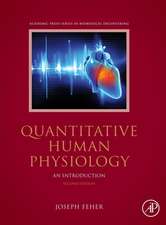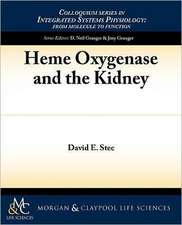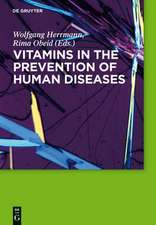Clinical Application of Computational Mechanics to the Cardiovascular System
Editat de T. Yamaguchien Limba Engleză Paperback – 3 oct 2013
| Toate formatele și edițiile | Preț | Express |
|---|---|---|
| Paperback (1) | 1160.60 lei 6-8 săpt. | |
| Springer – 3 oct 2013 | 1160.60 lei 6-8 săpt. | |
| Hardback (1) | 1102.82 lei 6-8 săpt. | |
| Springer – 30 noi 2000 | 1102.82 lei 6-8 săpt. |
Preț: 1160.60 lei
Preț vechi: 1221.68 lei
-5% Nou
Puncte Express: 1741
Preț estimativ în valută:
222.07€ • 231.87$ • 183.80£
222.07€ • 231.87$ • 183.80£
Carte tipărită la comandă
Livrare economică 04-18 aprilie
Preluare comenzi: 021 569.72.76
Specificații
ISBN-13: 9784431679899
ISBN-10: 4431679898
Pagini: 324
Ilustrații: XXXII, 288 p.
Dimensiuni: 155 x 235 x 17 mm
Greutate: 0.5 kg
Ediția:Softcover reprint of the original 1st ed. 2000
Editura: Springer
Colecția Springer
Locul publicării:Tokyo, Japan
ISBN-10: 4431679898
Pagini: 324
Ilustrații: XXXII, 288 p.
Dimensiuni: 155 x 235 x 17 mm
Greutate: 0.5 kg
Ediția:Softcover reprint of the original 1st ed. 2000
Editura: Springer
Colecția Springer
Locul publicării:Tokyo, Japan
Public țintă
ResearchDescriere
Vascular diseases, particularly atherosclerosis, are the most frequent and critical underlying fatal disorders in the industrialized world. Cardiovascular deaths are the leading cause of death in the Western world. Although cancer or malignant neoplasms recently have topped the list of causes of deaths in Japan, cardiovascular and cerebrovascular diseases bring about more deaths than cancer if they are reclassified into a unified category of diseases of the vascular system. The National Cardiovascular Center was established by the Ministry of Health and Welfare of Japan to combat cardiovascular and cerebrovascular diseases. Since the Center was opened, we have continued to support basic and clinical sturlies of cardiovascular and cerebrovascular diseases within as weil as outside the Center. Clinical studies that we have supported in modern diagnostic and therapeutic measures against cardio- and cerebrovascular diseases have made remarkable advances in recent years, especially in medical imaging technology including CT and MRI, and in interventional measures including balloon angioplasty and other catheter-based treatments. We are proud of the significant improvement in the overall survival rate and the quality of life of patients suffering from vascular disorders. However, there are still many essential difficulties remaining in the diagnosis and treatment of vascular disorders. Such difficulties necessitate further fundamental studies not only from the practical aspect but also from the integrated perspectives of medicine, biology, and engineering.
Cuprins
1. General Aspects of Computational Cardiovascular Mechanics.- 1.1 Computational Mechanical Model Studies in the Cardiovascular System.- 1.2 Inelastic Constitutive Models of Blood Vessels in Physiological Conditions.- 1.3 Stress and Strain Analyses of Blood Vessels in Physiological and Pathological Conditions.- 1.4 Development of Interactive Modeling System for the Computational Biomechanics Simulation Using Medical Imaging Data.- 1.5 A Modeling System of 3-Dimensional Blood Vessel Configuration for CFD Analysis.- 2. Wall Motion and Blood Flow in the Heart.- 2.1 Computational Analysis for Mechanical Functions of Left Ventricle.- 2.2 Automated Tracking of Tagged Magnetic Resonance Image for Assessment of Regional Cardiac Wall Function.- 2.3 Error Estimation and Smoothing for Regional Deformation Analysis of the Heart with Tagged Magnetic Resonance Images.- 2.4 Deformation Analysis of Human Left Ventricular Wall Using Magnetic Resonance Tagging Technique.- 2.5 Motion and Strain Analyses of Left Ventricular Wall Using Optical Flow.- 2.6 Intraventricular Blood Flow Analysis Using Robust CFD Models.- 3. Interactions Between the Blood Flow and Wall Motion in Vascular System.- 3.1 Computational Fluid Mechanics of the Blood Flow in an Aortic Vessel with Realistic Geometry.- 3.2 Numerical Simulation and Experiment of Pulsatile Flow in Modeled Aortic Arch.- 3.3 Flow Simulation of the Aortic Arch —Effect of the 3D Distortion on Flows in the Ordinary Helix Circular Tube—.- 3.4 Computational Fluid Mechanics of the Vortical Flow in Blood Vessel.- 3.5 Computational Study on LDL Transfer from Flowing Blood to Arterial Walls.- 3.6 Numerical Simulation of Co-operative Regulation in the Cerebral Microvascular Arcadal Network.- 3.7 Computational Fluid Dynamic Simulation of the Flow Through Venous Valve.- 4. Clinical and Electrophysiological Aspacts of Computational Mechanics of the Heart.- 4.1 A High-Performance Computation Method for Simulation of Cardiac Excitation Propagation Using a Supercomputer.- 4.2 Simulated Electrocardiogram of Spiral Wave Reentry in a Mathematical Ventricular Model.- 4.3 Computational Analysis and Visualization of Spiral Wave Reentry in a Virtual Heart Model.- 4.4 Simulation of Platelet Adhesion Using a Discrete Element Method.- 4.5 Computational Fluid Dynamics as a Tool to Develop the Artificial Heart.- 4.6 Three-Dimensional Image Processing and Motion Analysis of the Heart Using Radionuclide Medical Images.- 4.7 The Modeling of the Heart and the Aortic Arch Applying Differential Geometrical Method and Simulation of Blood Flow.- 4.8 Orientation Response of Stress Fibers in Cultured Cells Under Biaxial Cyclic Stretch: Hypothesis and Theoretical Prediction.
Caracteristici
Contains a number of color illustrations which helps the reader to understand the real virtue of the computational results
It can be used as a supplement data source for the postgraduate courses in biomedical engineering since the computational method is one of crucial technology in the field
It can be used as a supplement data source for the postgraduate courses in biomedical engineering since the computational method is one of crucial technology in the field




















